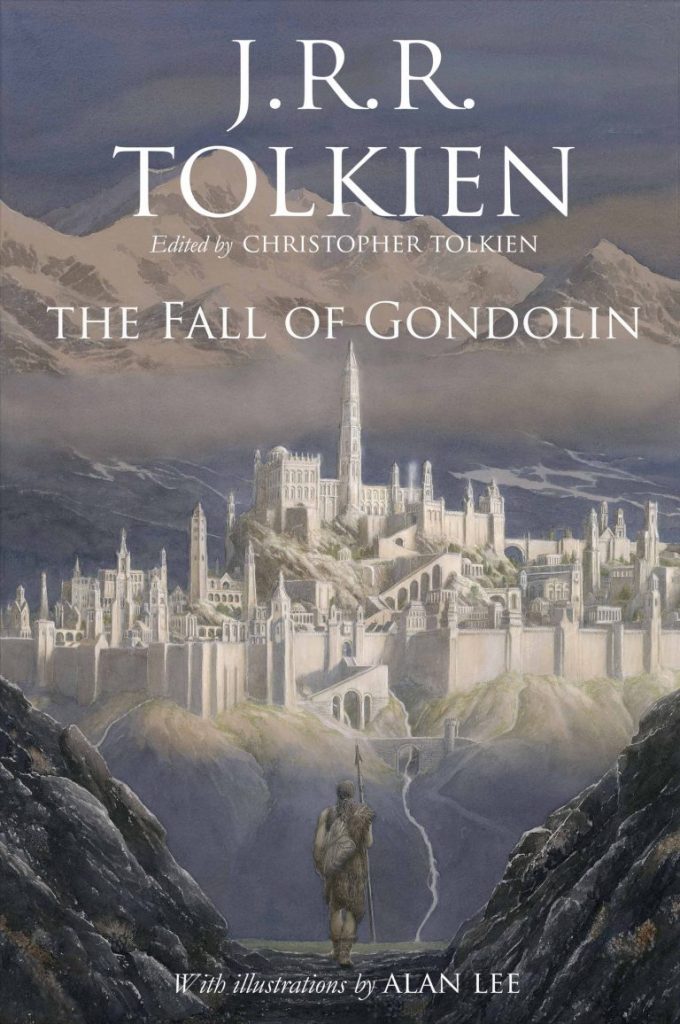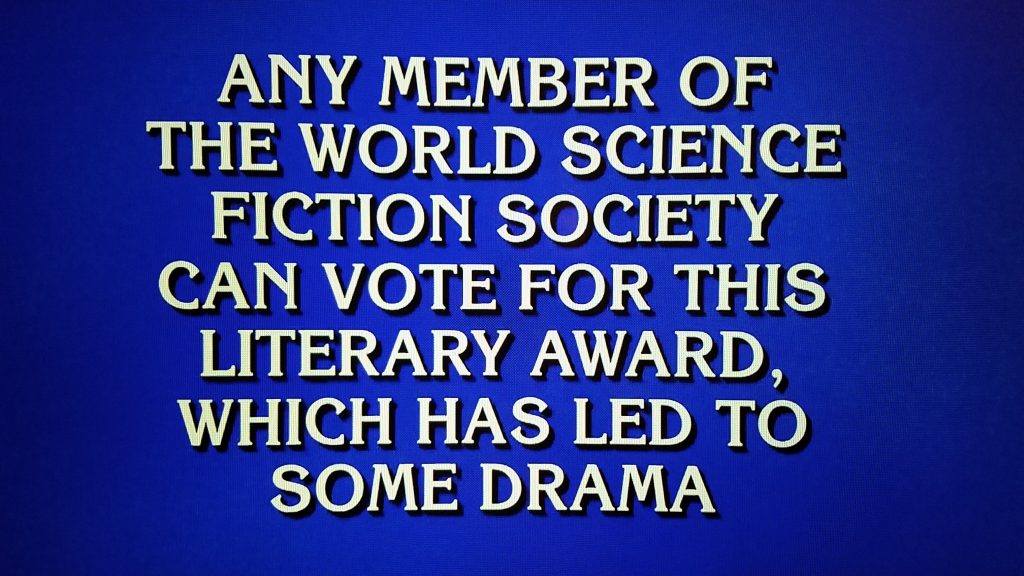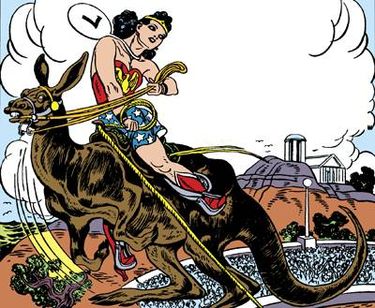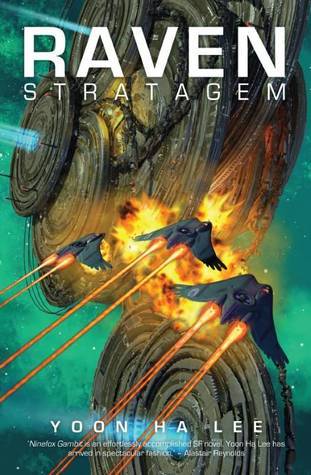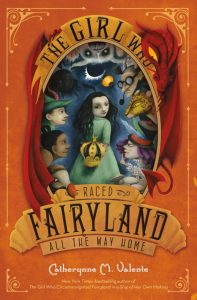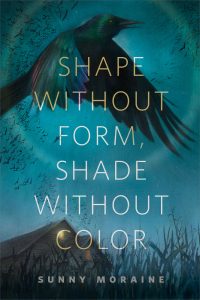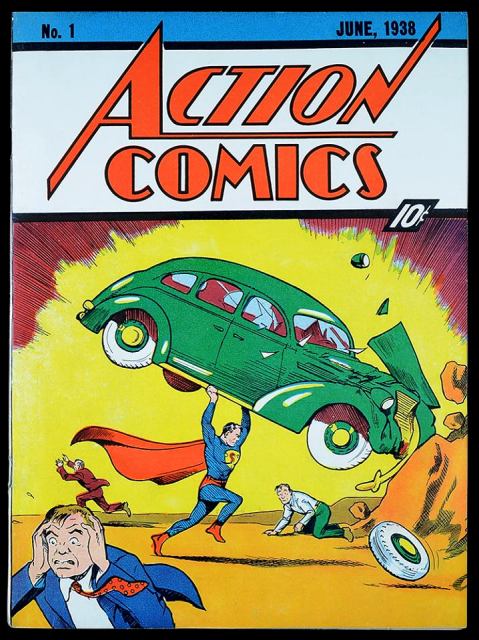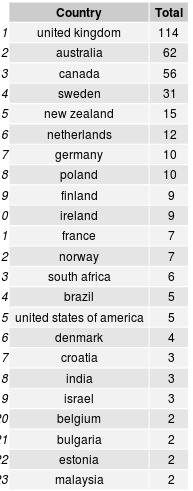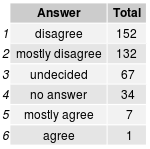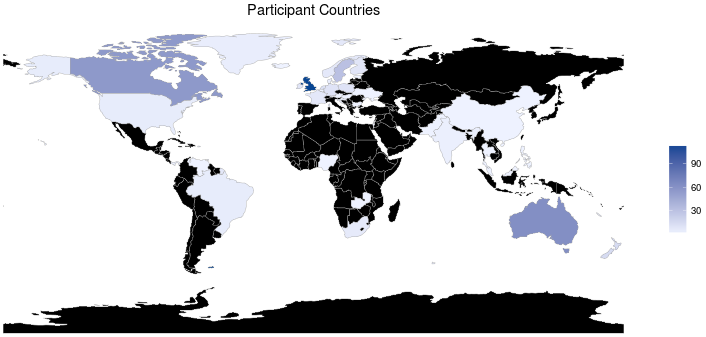(1) CASE DISMISSED. In May 2018, Fur Affinity, winner of the 2012 and 2013 Ursa Major Awards for Best Anthropomorphic Website, banned several dozen accounts for Code of Conduct violations — Section 2.7 “Do not identify with or promote real hate or terrorist organizations and their ideologies.”
Furry artist Scott Malcolmson (whose fursona is Roy Calbeck), filed suit in Arizona against IMVU, Fur Affinity’s parent company, on grounds of breach of contract and defamation of character.
The suit was dismissed on August 27. Boozy Badger analyzed the result in a Twitter thread which starts here.
https://twitter.com/BoozyBadger/status/1034904635398610944
IMVU is a Delaware corporation. The court did not find its connections to Arizona legally sufficient for IMVU to be sued there. The court further said:
Plaintiff objects that he is a per se litigant filing in forma pauperis. That may be so. However, in our legal system, there is but one law and it applies to rich and poor alike. That Mr. Malcomson is too impecunious to litigate in IMVU’s home state of Delaware cannot detract from IMVU’s constitutional right not to be sued in an improper forum.
Boozy Badger noted:
Jurisdiction, Forum, and Venue are literally most of a semester of Civil Procedure in law school. There are options OTHER than Delaware, but you can’t sue just anywhere.
Wikifur’s article on “History of Fur Affinity” has more background:
COC 2.7 bans (May 2018)[edit]
On May 15, 2018, several dozens FA accounts were banned from the site for presumed violations of the site’s updated Code of Conduct, Section 2.7 (“Do not identify with or promote real hate or terrorist organizations and their ideologies”).[68] This included personal and group accounts related to AltFurry (FurRight), Furry Raiders and other perceived Alt-Right connected accounts.
Complaints came in swift, from people claiming to be false positives[69][70] to banned and not banned users that argued that biased staff had failed to also struck down left-leaning “hate/terrorist” individuals and groups (e.g. Deo Tas Devil, Antifa, “Far-Left”/”Alt-left” accounts and Communist Furs).[71][72] Instructions were passed among the affected and sympathizers to vacate to other sites, specifically, InkBunny,[73][74][75] and discussions were started to pin down who was to blame for the bans (from Antifa-cowered FA staff to outright ban demands/orders from the online news site Dogpatch Press).[76][77]
It would be three days later (May 18), when legal proceedings initiated by Roy Calbeck were to take the form of a lawsuit against FA’s parent company, IMVU, for:
Defamation/Breach of Contract against IMVU for actions taken by their wholly-owned subsidiary, @FurAffinity…
(2) GONDOLIN FALLS TOMORROW. Smithsonian says after two lifetimes of work this probably is it: “J.R.R. Tolkien’s Final Posthumous Book Is Published”.
Though J.R.R. Tolkien passed away in 1973, he has never really stopped publishing. For decades his son and literary executor Christopher Tolkien has painstakingly catalogued and edited his father’s papers, creating new books out of unfinished and unpublished manuscripts. Most of those tales delve deep into the history of Middle-earth, the fantasy realm where Tolkien’s best known works, The Hobbit and The Lord of the Rings series take place. Now, it’s likely that work will come to an end with one last Tolkien book. Critic Andrew Ervin at The Washington Post reports that The Fall of Gondolin, which will be released tomorrow, is likely J.R.R. and Christopher Tolkien’s swan song.
(3) SFF MARKETING. Cat Rambo appeared on the Science Fiction & Fantasy Marketing podcast: “Writing Tips, Selling Short Fiction, and What SFWA Can Do for You with Cat Rambo”. Here are a few of the many topics touched on during the conversation:
- How Cat ended up publishing her first two Tabat novels through Kevin J. Anderson’s Wordfire Press (which he talked about when he was on Episode 194 and Episode 138) and how marketing goes when working with a small press.
- Some tips from her recent non-fiction publication Moving from Idea to Finished Draft.
- What’s been going on at SFWA since we had MCA Hogarth on the show back on Episode 20 (more than three years ago!) and why both trad and self-published may find a membership useful.
- What it takes to qualify for SFWA membership.
- Benefits that come with SFWA membership and how the Nebula convention has changed over the years to have helpful panels for all.
(4) FUTURE TENSE. This month’s entry in the Future Tense Fiction series: “When We Were Patched” by Deji Bryce Olukotun.
The last time we ever spoke, my partner Malik asked me whether I believed speed or power made for the best athlete. I was puzzled, of course, feeling that neither could explain why some athletes excelled more than others, even in straightforward competitions like sprinting or the javelin. “There are enough variables to make it unclear,” I observed, “whether speed or power offers a better advantage in competition, or whether some other factor confers the greatest advantage.” It seemed to me an unanswerable question….
It was published along with a response essay by algorithmic bias expert Jeanna Matthews, “Algorithms Could Create an Even Playing Field—if We Insist on It”.
Big decisions about our lives are increasingly made jointly by humans and computer systems. Do we get a loan? Are we invited for an interview? Who should we date? Which news stories should we read? Who won the tennis match? This is our reality today. In “When We were Patched,” Deji Olukotun explores what the boundaries of these human and machine partnerships will be. Could we get the best of both, or will we end up with the worst of both? …
Each month in 2018, Future Tense Fiction—a series of short stories from Future Tense and ASU’s Center for Science and the Imagination about how technology and science will change our lives—is publishing a story on a theme.
(5) FOLLOWING ARMSTRONG’S FOOTSTEPS. Slate compiles the early reviews: “Here’s What Critics Are Saying About First Man“.
Space! Now that I’ve got your attention, the reviews of Damien Chazelle’s First Man, which had its world premiere at the Venice Film Festival, today are in—and fortunately, like the film itself, there’s really no way for them to spoil the ending. The space drama follows Neil Armstrong (Ryan Gosling) in his literal and metaphorical journey to become the first man on the moon.
It’s a story and a genre we know all too well, but this doesn’t hold the film back—it even improves upon its galactic forbearers. Critics agree that the story is masterfully handled by Chazelle, who mixes realism with reverence, without overblowing the drama.
And of course, it’s simply an irresistible opportunity to employ space metaphors, whether that’s about “soaring,” “sky-high expectations,” “slip[ping] the surly bonds of earth or “shoot[ing] the moon.” (Michael Nordine at IndieWire wins this space race: “Chazelle is an adept flight commander, guiding the action with the elegance of a space dance in one scene and the intensity of a rocket launch in the next … It may not be a giant leap for filmmaking, but it’s another small step for this filmmaker.”)
(6) A WRITER’S DAY. John Scalzi’s to-do list for Wednesday.
Things to do today:
1. Go to the elections board to sign up for an absentee ballot
2. Pick up a new beard trimmer because I lost my previous one somewhere on the road
3. Go to Taco Bell and yell JESUS YOU CALL THAT A BURRITO until they kick me out AGAIN
— John Scalzi (@scalzi) August 29, 2018
(7) NEW HORIZONS SPOTS TARGET. NASA’s New Horizons spacecraft — which performed a Pluto flyby about three years ago — has officially spotted its next target (“Ultima in View: NASA’s New Horizons Makes First Detection of Kuiper Belt Flyby Target”). The craft took a series of long-duration images from which the star field was subtracted to pick out the Kuiper Belt object (nicknamed Ultima Thule) New Horizons is headed toward. The closest encounter with Ultima Thule is expected to be early (EST) New Year’s Day 2019.
Mission team members were thrilled – if not a little surprised – that New Horizons’ telescopic Long Range Reconnaissance Imager (LORRI) was able to see the small, dim object while still more than 100 million miles away, and against a dense background of stars. Taken Aug. 16 and transmitted home through NASA’s Deep Space Network over the following days, the set of 48 images marked the team’s first attempt to find Ultima with the spacecraft’s own cameras.
“The image field is extremely rich with background stars, which makes it difficult to detect faint objects,” said Hal Weaver, New Horizons project scientist and LORRI principal investigator from the Johns Hopkins Applied Physics Laboratory in Laurel, Maryland. “It really is like finding a needle in a haystack. In these first images, Ultima appears only as a bump on the side of a background star that’s roughly 17 times brighter, but Ultima will be getting brighter – and easier to see – as the spacecraft gets closer.”
This first detection is important because the observations New Horizons makes of Ultima over the next four months will help the mission team refine the spacecraft’s course toward a closest approach to Ultima, at 12:33 a.m. EST on Jan. 1, 2019. That Ultima was where mission scientists expected it to be – in precisely the spot they predicted, using data gathered by the Hubble Space Telescope – indicates the team already has a good idea of Ultima’s orbit.
(8) REMEMBERING WILLY LEY. Steven Levy’s WIRED article “385 Feet of Crazy: The Most Audacious Flying Machine Ever” is about Paul Allen’s effort to build a giant airplane called a Stratolaunch which he wants to use to carry rockets to the edge of space and then launch from the stratosphere. It includes this sentimental memory about a writer who was important to a lot of fans back in the day.
As a teenager, Paul Allen was a sci-fi and rocketry nerd. He dreamed of becoming an astronaut, but that ambition was scuttled by nearsightedness. His childhood bedroom was filled with science fiction and space books. Bill Gates remembers Allen’s obsession. “Even when I first met him—he was in tenth grade and I was in eighth—he had read way more science fiction than anyone else,” says Gates, who later founded Microsoft with Allen. “Way more.” One of Allen’s favorites was a popular science classic called Rockets, Missiles, and Space Travel, by Willy Ley, first published in 1944. As Allen tells it in his memoir, he was crushed when he visited his parents as an adult and went to his old room to reference a book. He discovered that his mother had sold his collection. (The sale price: $75.) Using a blowup of an old photo of the room, Allen dispatched scouts to painstakingly re-create his boyhood library.
(9) OPTIMUS SOLUTION. Daniel Cohen’s Financial Times article “Tales from the storage unit: inside a booming industry”, in a survey of storage spaces, recommends Inner Space Stations in York:
A large model of the Optimus Prime character from TRANSFORMERS stands beide the entrance of its main store, on a busy road. A Dalek is visible through a window; a model of a STAR WARS stormtrooper guards the reception. The sizes of the units correspond to planet s in the solar system; the smallest lockers have an image of Mercury on the door, while the biggest show Jupiter. ‘It’s just making fun,’ says Graham Kennedy, the owner. ‘Quite often there’s a stressful reason for going into storage. So I’ve decided to lighten it.’
(10) TODAY’S BIRTHDAYS
[Compiled by Cat Eldridge]
- Born August 29, 1898 – C.S. Lewis. Author of the Narnia books and The Space Trilogy, also The Screwtape Letters which I got assigned in University a very long time ago. Ardent Christian, he wrote three dense book on that religion, Mere Christianity, Miracles, and The Problem of Pain. There’s a Doctor Who episode with Matt Smith that riffs off the Narnia book entry way if memory serves me right.
- Born August 29 — Nancy Holder, 65. Perhaps best known for her myriad work, fiction and non-fiction, based off the Buffy the Vampire Slayer series. However I’ll single her out as a four-time winner of the Bram Stoker Award including Best Novel for Dead in the Water.
- Born August 29 – Michael P. Kube-McDowell, 64. Extensive writing in the Star Wars genre but also has written such novels as The Quiet Pools which was a Hugo Award nominee and Emprise which was a Philip K. Dick nominee. Several of his short stories were adapted into episodes of theTales from the Darkside series.
- Born August 29 — Lenny Henry, 60. Co-creator with Neil Gaiman and producer of the 1996 BBC drama serial Neverwhere. Narrator of Anansi Boys. Appeared, well appeared isn’t quite proper, in Harry Potter and the Prisoner of Azkaban as the voice of the Shrunken Head.
(11) COMICS SECTION.
- John King Tarpinian likes to think this is how it looked on the plane home from Worldcon 76 – Off the Mark.
- Jungle cruise: Rhymes with Orange.
(12) HISTORY REVEALED. Michael Cassutt will be signing The Astronaut Maker at Vroman’s Bookstore in Pasadena, CA on September 6. (More details at “Michael Cassutt discusses and signs The Astronaut Maker”).
One of the most elusive and controversial figures in NASA’s history, George W. S. Abbey was called “the Dark Lord,” “the Godfather,” and “UNO”–short for unidentified NASA official. He was said to be secretive, despotic, a Space Age Machiavelli. Yet Abbey had more influence on human spaceflight than almost anyone in history. His story has never been told–until now. The Astronaut Maker takes readers inside NASA to learn the real story of how Abbey rose to power, from young pilot and wannabe astronaut to engineer, bureaucrat, and finally director of the Johnson Space Center. During a thirty-seven-year career, mostly out of the spotlight, he oversaw the selection of every astronaut class from 1978 to 1987, deciding who got to fly and when. He was with the Apollo 1 astronauts the night before the fatal fire in January 1967. He was in mission control the night of the Apollo 13 accident and organized the recovery effort. Abbey also led NASA’s recruitment of women and minorities as space shuttle astronauts and was responsible for hiring Sally Ride. Written by Michael Cassutt, the coauthor of the acclaimed astronaut memoirs DEKE! and We Have Capture, and informed by countless hours of interviews with Abbey and his family, friends, adversaries, and former colleagues, The Astronaut Maker is the ultimate insider’s account of ambition and power politics at NASA. (Chicago Review Press)
(13) JUST DRAWN THAT WAY. Need a goat? Remember to smile: “Goats ‘drawn to happy human faces'”.
Scientists have found that goats are drawn to humans with happy facial expressions.
The result suggests a wider range of animals can read people’s moods than was previously thought.
The researchers showed goats pairs of photos of the same person, one of them featuring an angry expression, and the other a happy demeanour.
The goats made a beeline for the happy faces, the team reports in the journal Royal Society Open Science.
(14) THE ACME OF SOMETHING OR OTHER. Maybe this will be your cup of tea but I confess: I plan to be somewhere (anywhere) else when this picture is in theaters: “The ‘Wile E. Coyote’ Movie Has Ordered A Pair Of Writers Who Aren’t From ACME!”
The Roadrunner had better watch out as there is a new ‘Wile E. Coyote’ movie in the works and Warner Bros. has just tapped The Silberman Brothers (‘Living Biblically,’ ‘It’s Always Sunny In Philadelphia’) to write it! Jon and Josh are going to have a lot of work ahead of them to bring this iconic character to the big screen for an audience base that had significantly changed from when the toon was originally popular.
While this “Super Genius” will always be known for creative inventions that pave the way for perfect slapstick humor, the lack of dialogue for a feature film might mean that we’re getting some massive changes to the Wiley cartoon. While there is no mention of his arch nemesis and his uncatchable meal of The Roadrunner being part of the film, it would be hard to imagine a story that doesn’t include him.
(15) DIAL EIGHT. Another thing I didn’t get done at Worldcon 76 – meeting Galactic Journey’s Gideon Marcus. By now he’s back in 1963 keeping track of the myriad developments in outer space: “[August 29, 1963] Why we fly (August Space Round-up)”.
Bridging the Continents
Communication satellites continue to make our world a smaller place. Syncom, built by Hughes and launched by NASA late last month, is the first comsat to have a 24-hour orbit. From our perspective on the Earth’s surface, it appears to do figure eights around one spot in the sky rather than circling the Earth. This means Syncom can be a permanent relay station between the hemispheres.
It’s already being used. On August 4 the satellite allowed Nigerian journalists and folks from two U.S. services to exchange news stories as well as pictures of President Kennedy and Nigerian Governor General Dr. Nnamdi Zikiwe. Five days later, voice and teletype was exchanged between Paso Robles, California and Lagos, Nigeria. This 7,7700 mile conversation represents the longest range real-time communication ever made.
I think he means 7,700 miles – but of course I would!
(16) GAMING, IT’S NOT JUST FOR BREAKFAST ANYMORE. The BBC reports on the finding of an ancient gaming board and how it may be the clue to the location of an important lost monastery (“Medieval gaming board clue to lost monastery”).
The discovery of a medieval gaming board may have helped bring archaeologists closer to confirming the site of a lost early monastery.
Archaeologists have been actively seeking the Monastery of Deer in Aberdeenshire since about 2008.
Monks at the monastery wrote the important 10th Century illuminated manuscript, the Book of Deer.
Layers beneath the disc-shaped stone gaming board have been carbon dated to the 7th and 8th centuries.
Charcoal also found at the remains of a building uncovered by archaeologists during the latest dig at the site, near Mintlaw, has been dated to the same time, between 669 and 777AD.
Smithsonian follows up with more about the game board itself and its monastic connections (“Archaeologists Unearth Medieval Game Board During Search for Lost Monastery”).
According to The Scotsman’s Alison Campsie, monks likely used the board to play Hnefatafl, a Norse strategy game that pits a king and his defenders against two dozen taflmen, or attackers. As the king’s men attempt to herd him to safety in one of the four burgs, or refuges, located in the corners of the game board, taflmen work to thwart the escape. To end the game, the king must reach sanctuary or yield to captivity.
The board “is a very rare object,” archaeologist Ali Cameron of The Book of Deer Project, who is in charge of excavations, tells Campsie. “Only a few have been found in Scotland, mainly on monastic or at least religious sites. These gaming boards are not something everyone would have had access to.”
…The game board’s discovery and dating to the 7th and 8th centuries offer tantalizing indication that the dig site was, in fact, home to the medieval monastery, but as Mark Hall, a medieval games specialist at the Perth Museum and Art Gallery, cautions, “This temptation remains just that until further evidence presents itself to make a valid link between the disc and the date.”
(17) MORE COMICS CROSSOVERS. Daniel Dern is keeping an eye open for these: “Sometime within the last year we got a great bunch, notably the Batman/Elmer Fudd (including the narrated-by-Denny-ONeil video). A bunch just came out today, including Lex Luthor/Porky Pig, Joker/Daffy Duck, and Catwoman/Sylvester.”
And io9’s James Whitbrook looks ahead to when “All the Incredible New Comic Series to Cozy Up With This Fall”.
DC/Hanna-Barbera Crossovers—DC’s bizarro mashups between its comics universe and the animated antics of Hanna-Barbera’s most beloved creations continues with another wave of weird and wonderful adventures.
Deathstroke/Yogi Bear #1—Frank Tieri, Mark Texeira
Green Lantern/Huckleberry Hound #1—Mark Russell, Rick Leonardi
Nightwing/Magilla Gorilla #1—Heath Corson, Tom Grummett
Superman/Top Cat #1—Dan DiDio, Shane Davis
(18) GAME OVER. Camestros Felapton discovered spammers have taken over the abandoned Sad Puppies IV website but kept most of the content to make it look like Kate Paulk is selling slot machines in Italian –
[Thanks to ULTRAGOTHA, John King Tarpinian, Cat Rambo, Mike Kennedy, JJ, Cat Eldridge, Martin Morse Wooster, Chip Hitchcock, Joey Eschrich, mlex, Daniel Dern, Michael Toman, Carl Slaughter, and Andrew Porter for some of these stories. Title credit goes to File 770 contributing editor of the day Andrew.]

